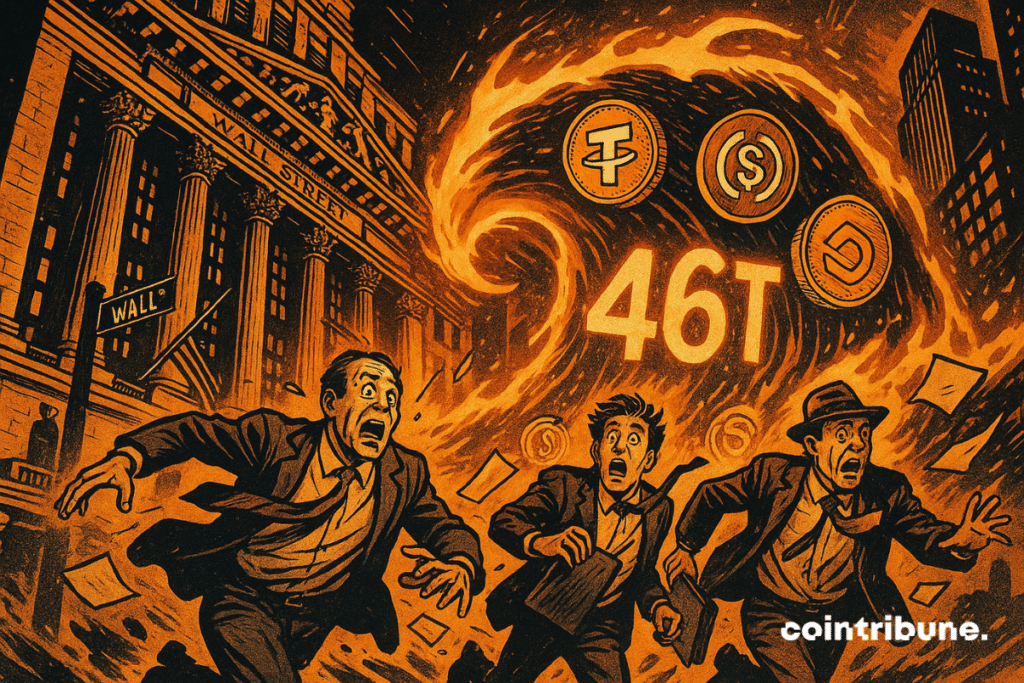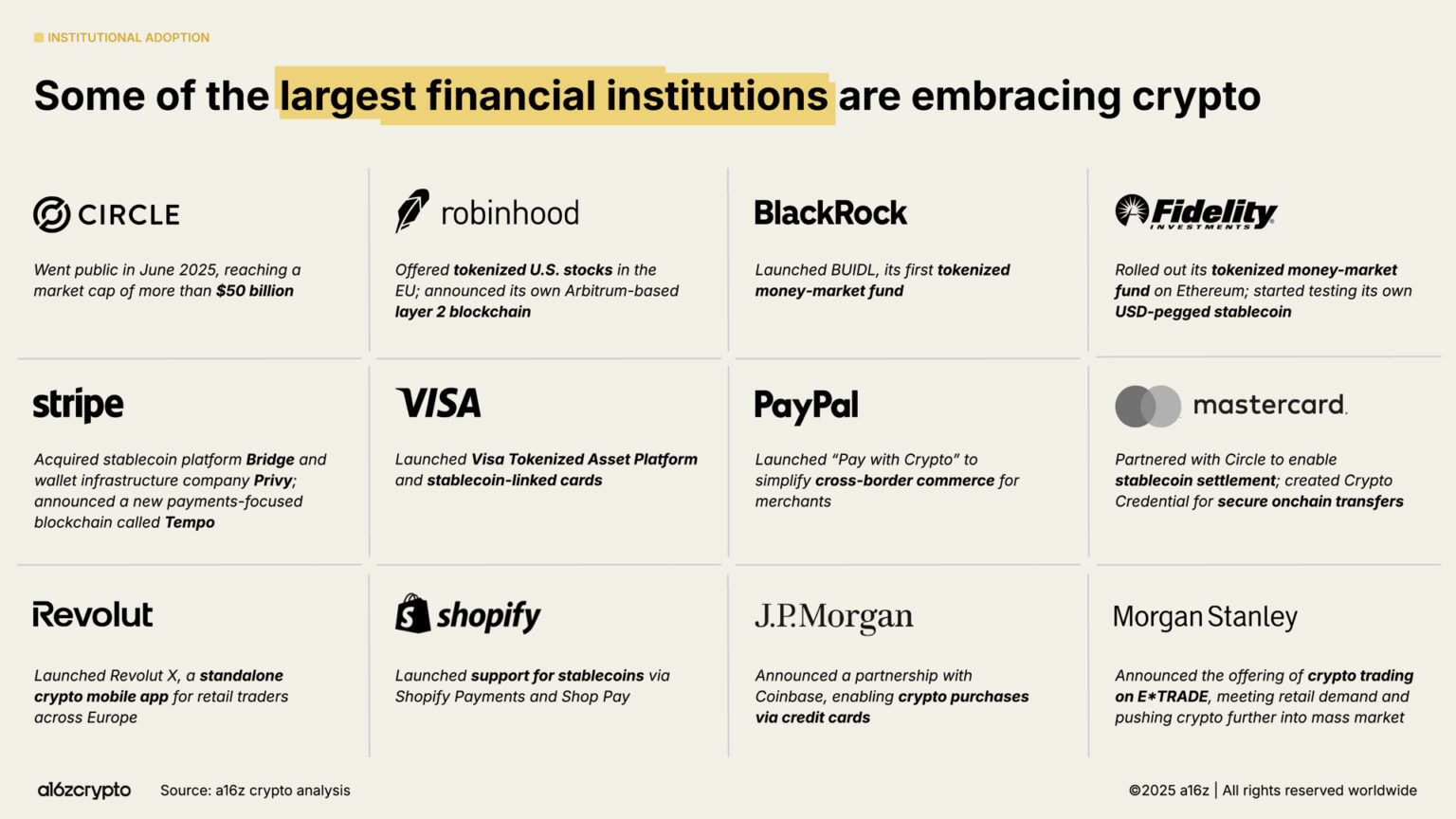The Rapid Rise of Stablecoins Sends Wall Street into a Frenzy
Global finance is evolving. Slowly but surely, a new paradigm is taking hold. And guess which technology is infiltrating everywhere, at high speed? It’s neither AI nor neobanks. It’s crypto. More specifically: stablecoins, those digital tokens pegged to the dollar. They used to be marginal tools for traders; today, they are at the heart of major financial maneuvers. And while some applaud, others on Wall Street are beginning to worry.

In brief
- Stablecoins processed 46 trillion dollars in transactions in a single year.
- Visa, Fidelity, and JPMorgan now invest in products and services related to stablecoins.
- Blockchain speed reaches 3,400 transactions per second, making crypto more accessible than ever.
- USDT and USDC hold 87% of the stablecoin market, with $300 billion in circulation.
Stablecoins: from Crypto Niche to the Backbone of Global Finance
Stablecoins, initially simple alternatives to transfers between crypto platforms, have become economic giants. In 2025, they processed 46 trillion dollars worth of transactions. By comparison, this is nearly three times Visa’s volume over the same period. Even adjusted to eliminate artificial effects, this figure remains astronomical: 9 trillion dollars, far exceeding PayPal.
According to the State of Crypto 2025 report published by a16z:
Stablecoins once mostly served to settle speculative crypto transactions; in recent years, they have become the fastest, cheapest, and most universal way to send a dollar — in less than a second, for less than a cent, almost anywhere in the world.
And this is just the beginning. The number of active crypto users ranges between 40 and 70 million, with growth mainly coming from emerging countries like Argentina or Nigeria. Where banking systems falter, stablecoins assert themselves as a safe haven, as a more reliable means of exchange than local currency. At this pace, the tokenized dollar is becoming the real dollar of global markets.
Wall Street Wants Its Share of the Stablecoin Pie
Finance giants no longer look down on crypto. They invest in it, integrate it, distribute it. Visa, JPMorgan, Fidelity, BlackRock, Mastercard, Citi, Morgan Stanley: all are now in the loop. Some already offer the purchase of stablecoins from their platforms. Others develop blockchains or integrate stablecoins into their customer services.

Circle, the issuer of USDC, even made its stock market debut. And crypto exchange-traded products (ETPs) exceed 175 billion dollars in assets under management. The BlackRock Bitcoin Trust has become one of the most successful launches in history.
As a16z summarizes:
These companies have immense distribution reach. If development continues, crypto could deeply integrate into the financial services we use daily.
Stablecoins, meanwhile, continue to grow: more than 300 billion dollars in circulation, with 87% held by Tether (USDT) and USDC. They also hold 150 billion dollars in US Treasury bonds, making them the 17th largest holder of US debt worldwide. Some analysts see this as a stability lever for the dollar; others, as an unprecedented Treasury dependence on private actors.
Crypto, AI, Finance: The Convergence Rebuilding the System
While markets heat up, crypto technology enters a new era. Blockchains, once slow and costly, now reach processing speeds of 3,400 transactions per second. Solana and Ethereum dominate. Layer 2 solutions like Arbitrum and Optimism reduce fees to less than a cent. For users, the motto is simple: crypto is ready for mass adoption.
And AI is never far away. Decentralized protocols explore solutions for autonomous agent payments, digital identity management, and privacy. Giants like Stripe invest heavily in stablecoin infrastructure. Forecasts? A tenfold growth by 2030 to reach 3 trillion dollars in capitalization.
Key numbers that speak loudly:
- $46 trillion in stablecoin transactions in 2025;
- 87% of the market held by USDT and USDC;
- $150 billion in Treasury bonds held by stablecoins;
- 3,400 TPS: blockchain performance multiplied by 100 in 5 years.
But not everyone is celebrating this rise. US Senator Elizabeth Warren has publicly criticized the GENIUS Act, which she considers too favorable to private interests. For her, stablecoins represent a systemic risk if they escape strict control. If finance changes its face, it won’t come out unscathed. And the political battle is only beginning.
Maximize your Cointribune experience with our "Read to Earn" program! For every article you read, earn points and access exclusive rewards. Sign up now and start earning benefits.
La révolution blockchain et crypto est en marche ! Et le jour où les impacts se feront ressentir sur l’économie la plus vulnérable de ce Monde, contre toute espérance, je dirai que j’y étais pour quelque chose
The views, thoughts, and opinions expressed in this article belong solely to the author, and should not be taken as investment advice. Do your own research before taking any investment decisions.